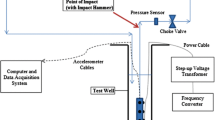Abstract
Reciprocating compressors are sources of vibration excitation in hydrotreating units used in the oil refinement industry. Due to their operating principle, these compressors can produce high levels of vibration in the pipes connected to it, which can affect their structural integrity and life span. Continuous vibration monitoring can be a difficult task due to the limited number of sensors and poor accessibility of the places with higher risk of failures. In this work, a methodology is proposed for predicting vibration responses in non-instrumented locations. For this, an output-only modal analysis of the interstage system was carried out and a finite element model of the system was developed to calibrate the numerical mode shapes or, in other words, to smooth the experimental mode shapes. The System Equivalent Reduction Expansion Process (SEREP) was used to reduce the numerical degrees of freedom and the Local Correspondence Principle for Modes and Coordinates (LCMC) was used in the smoothing process. Finally, the smoothed version of the experimental modal matrix was expanded using the modal expansion method and used to predict the vibration responses. Results showed high accuracy between the measured vibration data and the predicted ones.














Similar content being viewed by others
Availability of data
We confirm that data is open and transparent.
Code availability
Not applicable
Change history
07 February 2022
A Correction to this paper has been published: https://doi.org/10.1007/s00170-022-08876-z
References
IEA (2017) Data and Statistics - Total primary energy by source. https://www.iea.org/data-and-statistics?country=WORLD&fuel=Energy%20supply&indicator=Total%20primary%20energy%20supply%20(TPES)%20by%20source
Mckinsey (2020) Mckinsey Energy Insights - Hydrotreater. https://www.mckinseyenergyinsights.com/resources/refinery-reference-desk/hydrotreater/
Chen Y, Joffre D, Avitabile P (2018) Underwater Dynamic Response at Limited Points Expanded to Full-Field Displacement Response. ASME J Vib Acoust 140(October), https://doi.org/10.1115/1.4039800
Chipman C, Avitabile P (2012) Expansion of transient operating data. Mech Syst Signal Process 31:1–12. https://doi.org/10.1016/j.ymssp.2012.04.013
Kullaa J (2016) Virtual sensing of structural vibrations using dynamic substructuring. Mech Syst Signal Process 79:203–224. https://doi.org/10.1016/j.ymssp.2016.02.045
Avitabile P (2005) Model reduction and model expansion and their applications Part 1 - Theory. Conference Proceedings of the Society for Experimental Mechanics Series
Pingle P, Avitabile P (2011) Full-field dynamic stress/strain from limited sets of measured data. Sound and Vibration 45(8):10–14
Sestieri A, D’Ambrogio W, Brincker R, Skafte A, Culla A (2013) Estimation of Rotational Degrees of Freedom by EMA and FEM Mode Shapes. Conference Proceedings of the Society for Experimental Mechanics Series, pp 355–365. https://doi.org/10.1007/978-1-4614-6546-1_38
Iliopoulos AN, Devriendt C, Iliopoulos SN (2014) Van Hemelrijck D (2014) Continuous fatigue assessment of offshore wind turbines using a stress prediction technique. Health Monit Struct Bio Syst 9064:90640S. https://doi.org/10.1117/12.2045576
Qu ZQ (2004) Model Order Reduction Techniques. Springer, London, London,. https://doi.org/10.1007/978-1-4471-3827-3
Friswell MI, Mottershead JE (1995). Finite element model updating in structural dynamics. https://doi.org/10.1007/978-94-015-8508-8
Brincker R, Skafte A, López-Aenlle M, Sestieri A, D’Ambrogio W, Canteli A (2014) A local correspondence principle for mode shapes in structural dynamics. Mech Syst Signal Process 45(1):91–104. https://doi.org/10.1016/j.ymssp.2013.10.025
Iliopoulos A, Shirzadeh R, Weijtjens W, Guillaume P, Hemelrijck DV, Devriendt C (2016) A modal decomposition and expansion approach for prediction of dynamic responses on a monopile offshore wind turbine using a limited number of vibration sensors. Mech Syst Signal Process 68–69:84–104. https://doi.org/10.1016/j.ymssp.2015.07.016
Tarpø M, Nabuco B, Georgakis C, Brincker R (2020) Expansion of experimental mode shape from operational modal analysis and virtual sensing for fatigue analysis using the modal expansion method. Int J Fatigue. https://doi.org/10.1016/j.ijfatigue.2019.105280
Mendonça CDO, Gutiérrez RH, Monteiro UA (2021) Prediction of dynamic responses in a rectangular beam using the modal expansion method. Mar Syst Ocean Technol. https://doi.org/10.1007/s40868-020-00091-3
Maes K, De Roeck G, Lombaert G (2014) Response estimation in structural dynamics. Proceedings of the International Conference on Structural Dynamic , EURODYN 2014-Janua(July):2399–2406
Wang X, Wang Y, Tao F, Liu A (2021) New paradigm of data-driven smart customisation through digital twin. J Manuf Syst 58:270–280, https://doi.org/10.1016/j.jmsy.2020.07.023, digital Twin towards Smart Manufacturing and Industry 4.0
Huamani JA, Monteiro UA, Troyman AC, Vaz LA (2017) Output-only modal analysis of an electrical submersible pump installed in a mock well using time output-only modal analysis. XXXVIII Iberian-Latin American Congress on Computational Methods in Engineering. https://doi.org/10.20906/CPS/CILAMCE2017-0428
Busson L, Monteiro UA, Gutiérrez RH, Vaz LA (2019) Output-Only Modal Parameter Identification Rectangular Beam Using Mimo and Simo Tests of Output-Only Modal Analysis. In: Ibero-latin american congress on computational methods in engineering, Natal, RN - Brazil
Brincker R, Ventura CE (2015) Introduction to Operational Modal Analysis. John Wiley & Sons Ltd, Chichester, UK,. https://doi.org/10.1002/9781118535141
Jacobsen NJ, Andersen P (2008) Operational modal analysis on structures with rotating parts. 23rd International Conference on Noise and Vibration Engineering 2008, ISMA 2008 4:2491–2505
O’Callahan J, Avitabile P, Riemer R (1989) System equivalent reduction expansion process (SEREP). Proceedings of the International Modal Analysis Conference - IMAC XVII pp 29–37
Avitabile P (1998) Overview of Analytical and Experimental Modal Model Correlation Techniques Modal Model Correlation Techniques
Paultre P (2011) Dynamic of Structures. London
Allemang RJ (2003) The Modal Assurance Criterion Twenty Years of Use and Abuse. Sound and Vibration August(February)
Author information
Authors and Affiliations
Contributions
Claudio O. Mendosa contributed to conceptualization, investigation, writing—original draft, and writing—review and editing. Ulisses A. Monteiro: Ricardo H. R. Gutiérrez contributed to conceptualization, conceived and planned the experiments and writing—review. Luiz A. Vaz was in charge of overall direction and planning and review. Jorivaldo Medeiros contributed to experiment planning, analyzed experimental data and review. Ediberto B. Tinoco developed the FE models necessary to conduct the methodology and review
Corresponding author
Ethics declarations
Ethics approval
Not applicable
Competing interests
The authors declare no competing interests.
Additional information
Publisher’s Note
Springer Nature remains neutral with regard to jurisdictional claims in published maps and institutional affiliations.
The original online version of this article was revised: Author name “Claudio de O. Mendonsa” should be presented as “Claudio de O. Mendonça”
Rights and permissions
About this article
Cite this article
Mendonça, C.d.O., Monteiro, U.A., Gutierrez, R.H.R. et al. Prediction of vibration responses in a reciprocating compressor interstage piping system using the modal expansion method. Int J Adv Manuf Technol 119, 4073–4089 (2022). https://doi.org/10.1007/s00170-021-08490-5
Received:
Accepted:
Published:
Issue Date:
DOI: https://doi.org/10.1007/s00170-021-08490-5




